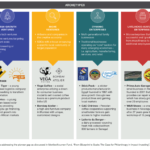Borrowing and Saving – Not Two Sides of the Same Coin
From a mathematical point of view, borrowing and saving are mirror images. In both cases many small payments allow for one or more large payouts. Only the sequence differs. Stuart Rutherford’s classic description involves “saving up” (saving) and “saving down” (borrowing), both for the purpose of assembling “usefully large sums.” When viewed in this way it is clear that saving and borrowing can serve much the same purpose, and at times can even substitute for each other.
This is true, as far as it goes, and it underscores the importance of disciplined payments of small amounts as a path to obtaining the lump sums needed for major purchases.
We recently traveled to India (Mumbai and rural Maharashtra) and Kenya (Nairobi and farming villages outside of Nyahururu) as part of a research project led by the Center for Financial Services Innovation and the Center for Financial Inclusion, and conducted by Dalberg. In speaking with a variety of residents, we were struck by vast differences in the way people make borrowing and savings decisions.
The people we talked with carried out most of their financial actions through informal instruments, though many were members of cooperatives and some did have (largely inactive) bank accounts. Instead of using these formal options, they borrowed mostly from friends, family and moneylenders. They saved in cash stashed at home, livestock, land and gold, amongst other assets. We asked how they decided where and how to save and borrow. They very willingly described their thought processes and the considerations that guide them in making decisions. As it turns out, their decisions about borrowing hang on surprisingly different criteria from those about saving, bearing on very different realms of their lives.
For these individuals, borrowing raises both practical and social considerations. The practical questions are rather straightforward. Who actually has the money and how much hassle will it be to get it? The social questions are much more fraught. They’re all about relationships. When people need to borrow, they evaluate their relationships to determine who to borrow from given the nature of the need. A loan connects the borrower in a new way with the lender. It both draws them closer and puts their relationship at risk. Loans may also create reciprocal obligations, monetary and/or social, though the latter may not be explicit.
With this in mind, we heard many people describe how they turn to different people for different purposes. Some said they would usually prefer to borrow from friends rather than family, and that they would rely on family as a last resort. If they failed to repay the loan, it would be easier to damage a relationship with friends, who come and go, than with family, with whom you remain permanently linked. One farmer in a village outside Nyahururu summarized it like this: “With family the problem stays, but with friends the friendship can end.” The desire to borrow in the context of a less personal relationship was also a stated reason for borrowing from moneylenders rather than friends and family, especially in rural Maharashtra. Given that moneylenders in this area tended to be large land owners, moneylender loans could be paid off through daily wage labor, which was something the villagers did anyway and which may have seemed easy to envision as a repayment strategy. Moneylenders were also named as the preferred source for larger loans, for practical reasons: They are more likely to have the money and provide it quickly. A goat herder explained it simply: “None of us have any money. We’re all in a similar situation; we don’t want to burden each other.”
The savings calculation is different. It’s more about economics. The key savings question is: How can I put my money to work while keeping it safe? Across locations we visited in Kenya and India, people weighed the pros and cons of saving in monetary form against other economic options, like buying livestock, land or gold, or paying for children to stay in school. While there are undoubtedly social considerations (livestock, land and gold convey status, for example), they are not the core of the decision.
People we spoke with thought about putting away money in two different categories that represent a spectrum: inflexible, needs-driven savings (e.g. savings for anticipated basic expenses like rent, loan payments and in some cases school fees), and more flexible investment-driven savings (e.g. for business expansion or land and livestock purchases). People tended to think about money put away for basic needs as less fungible and more fixed. On the other hand, people tended to consider savings for future investment opportunities as fungible, to be flexibly used for plan B or C if plan A does not materialize or unforeseen needs arise.
Both needs-driven and investment-driven savings can take monetary form (e.g. formal savings accounts or ROSCAs) or economic form (e.g. business inventory or livestock). The key consideration is matching the mechanism to the size, timing and return needed for the specific purpose. People also seek to strike a balance between liquidity and self-discipline in their choice of mechanism.
We find it fascinating that the considerations in borrowing and saving occupy such different psychological, social and economic domains. Borrowing, at least at the village level, is all about relationships and getting the money fast, while savings is about productivity and discipline.
These observations have profound implications for formal financial service providers. Formal providers would do well to think of their offerings in terms of these different domains. In fact, the alternatives described here set the competitive bar they must clear in order to attract customers. As one farmer in rural Kenya put it, in giving a straightforward explanation of his preference: “Banks are too formal, they’re office-based and institutional. Chamas (informal savings groups) consist of people helping each other out.”
For loans, the competition is other relationships, and this is good news for lenders. Formal lenders can offer privacy and freedom from entangling relationships. People may even put up with a certain amount of bureaucracy and be willing to pay if they can thereby obtain a loan relatively free of emotional baggage. However, personal relationships offer a degree of flexibility with the terms of repayment, which many people consider an essential component to a loan, given the volatility and difficulty they face anticipating their income.
The savings challenge is much harder to solve. Savings providers must outperform alternatives in terms of productivity (economic return) and several other attributes, but it is exceedingly difficult to offer such positive returns when the amounts saved are small. One way we observed to increase the perceived productivity of savings is to use them as a ticket to access loans. In Kenya, we heard about the popularity of the credit union practice of providing loans at a multiple of the amount saved. Even if the interest paid on savings is negligible, by opening the door to a loan it may appear as a more productive proposition than in-kind savings alternatives. One farmer in Kenya told us that “the SACCO (credit union) is my chama and my bank, it does everything for me.” Another explained that “the reason I’m in a chama is to buy shares in my SACCO … with more shares I have higher borrowing power.” His perspective pushes back against critics of mandatory savings in microfinance, which development specialists generally view as a technique to disguise interest rates. This customer, in contrast, viewed it as part of a productive economic strategy.
As we move up the income pyramid, it may be that choices about savings and credit become more like the inverse operations they are mathematically. Purely economic and financial considerations may become more salient while social and emotional considerations recede. However, we can be fairly certain that the gist of the sentiments we heard resonates with experience from other regions, settings and income levels. We recently read a quote from a small business owner in Latin America. He expressed his lack of interest in bank savings, and commented that, in his view, money in the bank is “dead.”
(The visits discussed here were part of Dalberg-conducted research for the Gates Foundation-funded project on financial health which is led by the Center for Financial Services Innovation and the Center for Financial Inclusion. Main results are expected in October.)
Photo credit: meenakshi madhavan, via Flickr.
Elisabeth Rhyne works to bring together leaders in financial services to address challenges facing the microfinance industry today. Michael Mori is a researcher and designer, and works as a senior designer with Dalberg Design Impact Group.
- Categories
- Uncategorized



